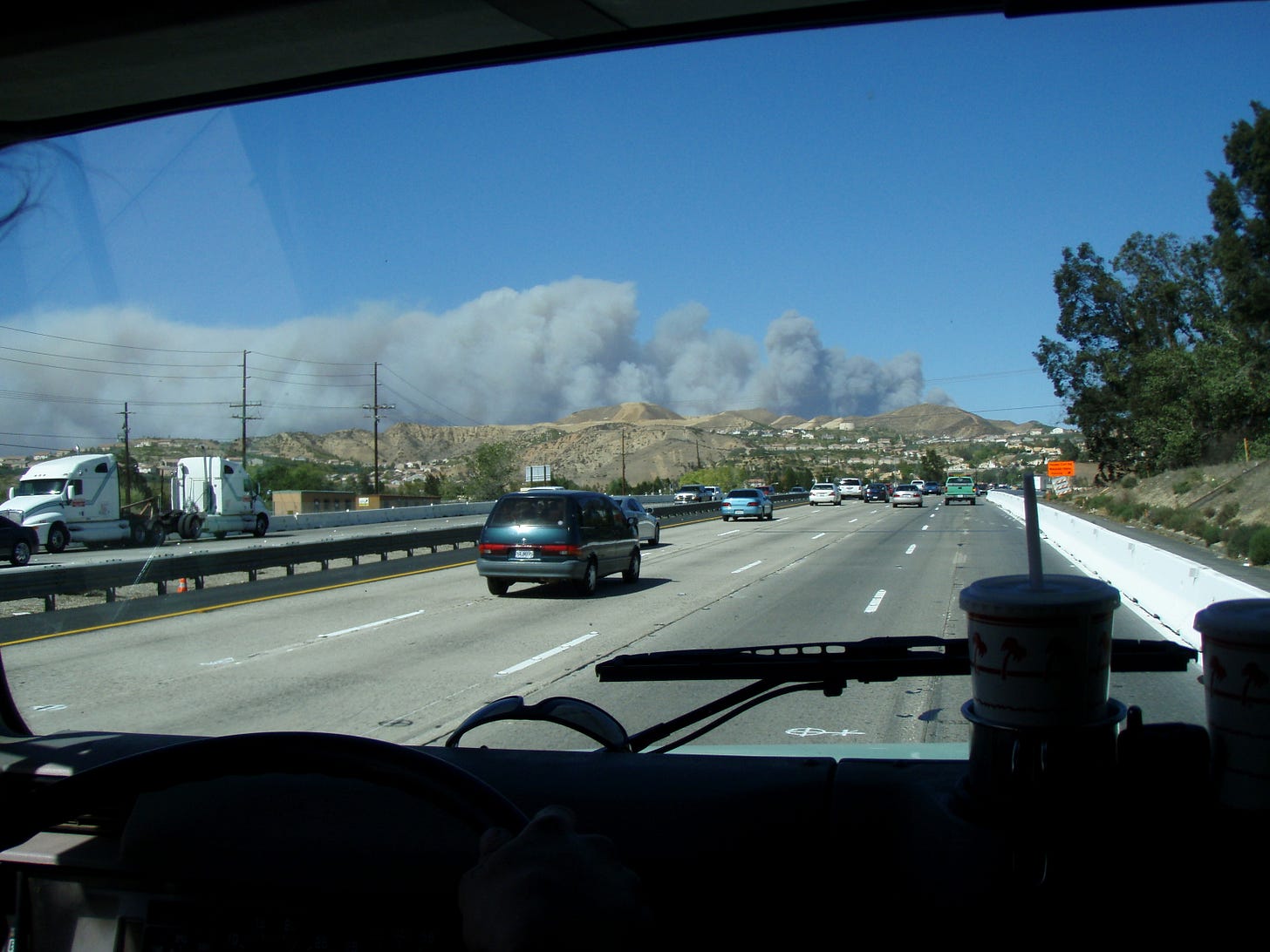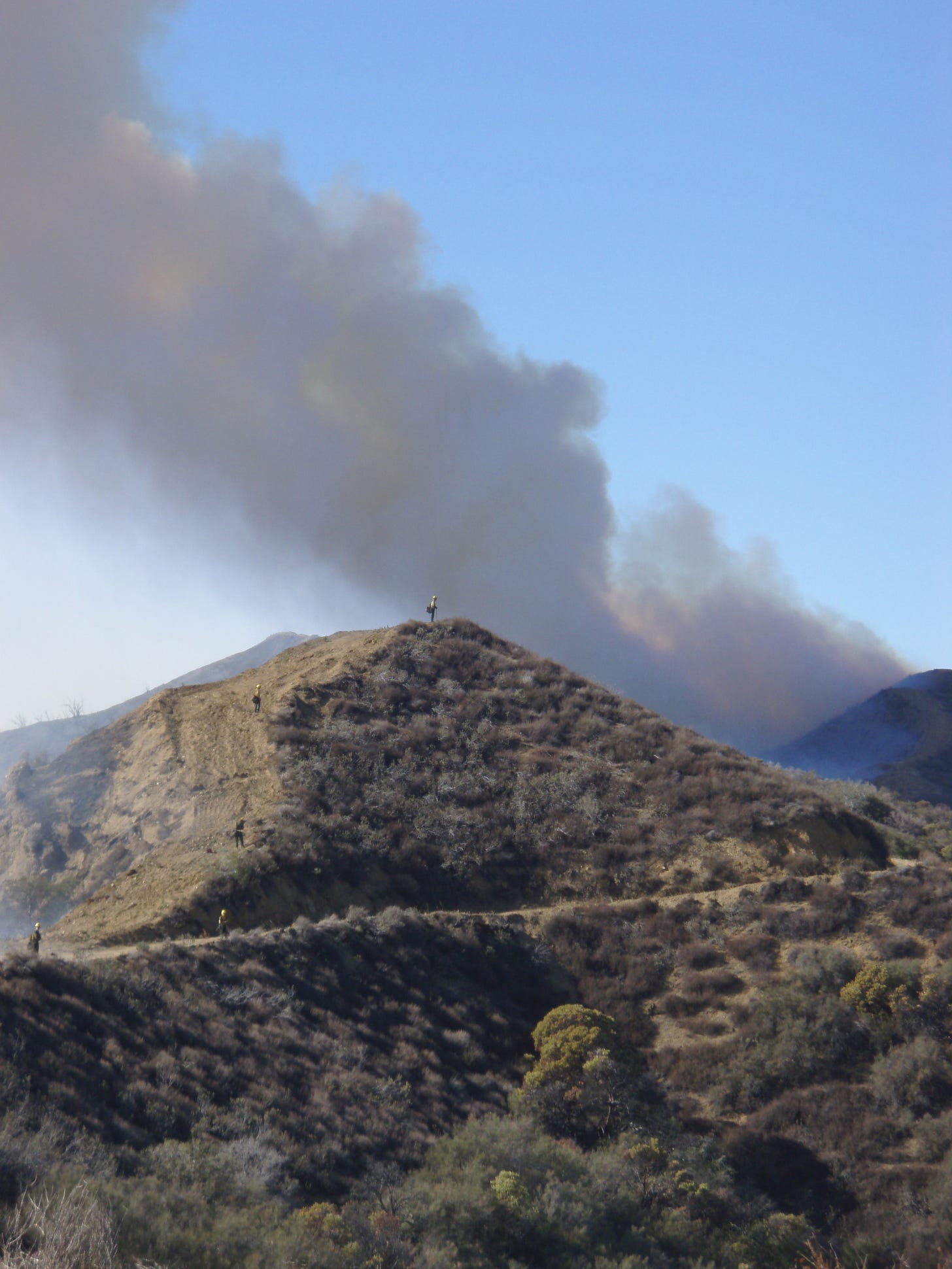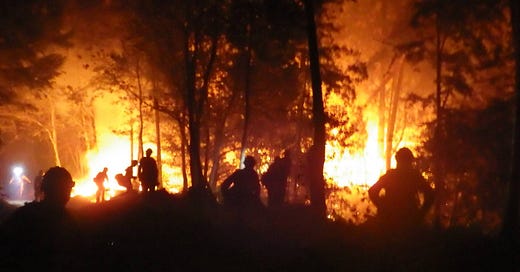Wildland-Urban Interface: Three Points
A Discussion of Three Points Surrounding the Wildland-Urban Interface. This Post is Concerned with Broader Contextual Wildland-Urban Interface Factors that Contribute to Home Ignition Narratives.
Introduction
The following is a collection of three ideas presented here as prompts for further thinking and discussion. This post is more interested in the abstract context of the Wildland-Urban Interface (WUI) and other housed areas that can potentially become part of rapid-fire growth and is not focused directly on home ignition and technical aspects. The three concerns presented here attach to and support technical aspects of the ongoing deadly and destructive situation in Los Angeles.
How did the WUI get There?
If you follow Cohen's work, you will learn, at a minimum, about preventing home ignition. However, I am less confident that this body of work or related narratives will draw focus to why homes are in the WUI in the first place. I would be happy to be proven wrong. This discussion also includes developments not necessarily in the WUI but built in a manner that increases the probability of conflagration.
The fire community might look at what has happened, shake its fist at the sky, and shout the all-too-familiar phrase, "This is a policy failure!" It appears to have been at least one or two policy failures and will likely continue to be one post-fire. If fire-minded building policy is the goal, what diluted form can proponents expect to arrive at, and after how many years? What is there time for? Should fire managers be looking to operate constructively with networks of societal outrage over the entire situation? Can society outpace government and self-organize into a system that can produce real-world solutions?
The problem underlying the WUI is the same one pervasive in unsustainable business practices and lifestyles, mass consumption, and the planned obsolescence of technologies like iPhones: economics. The dominant economic model present here is founded first on extraction. Developers extract buildable space from the earth; they define and build on all passable lots, efficiently build homes, and then extract as much money as possible from homebuyers. Driven by the desire to extract as much as possible from each situation regardless of location, unless required to meet specific codes, there is a blindness to fire risk as it is not part of extracting maximum value.
A second characteristic of this economic model is growth, which refers to revenue, capabilities, and business size growth. While growth is always limited, it is frequently approached as if it were limitless. If growth is thought to have no limits, builders and large-scale developers freely pursue increasing their revenue and possibilities. If a weak regulatory environment exists or widespread construction occurs before enforceable building codes, the spirit of limitless growth thrives, inspiring the construction of more homes in more places. If there are no recognized limitations to growth in the construction of homes and communities, then structures are again built without concern for fire risk. Acknowledging fire risk and refusing to build a multi-million dollar home because of it is a limit to growth and does not fit with the economic principles of the company. Growth is about building more and more homes wherever they are desired, and anywhere they fit.
A construction economy characterized by extraction and growth offers an early and abbreviated explanation for homes in places that, from the perspective of the wildfire community, make no sense. Why is this home here? Who put this here? It never stood a chance! One after another, roads with one way in and one way out, lined by brush going up the mountain, leading to clusters of secluded homes surrounded by trees and other vegetation. A completely fabricated pending WUI disaster.
The extractive principle clears lots, builds homes using cost-saving, lean construction methods, and then extracts maximum profits from buyers. The growth principle seeks to scale these activities by working in a wider geographic area and building wherever possible. Together, extraction and growth put homes in places that may cost more to defend than they are collectively worth. This economic model will be replicated in businesses that harden homes and create defensible space and fire technology.
The WUI problem appears to be an economic problem, as it is financially sensible for builders to construct homes in it and, generally, wherever else they will fit, even if these compressed communities are both at fire risk and create fire risk. This raises questions about influencing, redirecting, or constraining an industry anticipating building thousands of homes, extracting value from the disaster, and growing revenue.

Something Called the Truth
Ideas of wildfire, its management, and construction in areas with a propensity for it, such as the WUI and tightly-spaced developments, are a matter of truths and the context in which they remain truthful. Managing development and wildfire in the WUI and other areas where homes can easily be absorbed into the burning fuel model involves many truths. Some of these truths relate to the ways to harden homes best, others to the use of technology such as fire modeling and networks of cameras, water curtains, heavy equipment, and the use of fuel breaks to prevent fire from spreading into the community. Believers in these truths are confident they hold the truth of the home destruction by wildfire problem and how to solve it. As we live in a multiverse, multiple truths regarding the same idea are permissible and expected. However, the language that asserts them and the realities and actions these truths bring forth are not equally legitimate or desirable, nor will they all persist as problems are identified in one truth through interaction with others. The truth and desirability of any technology or strategy to protect areas vulnerable to wildfire is determined only through its interaction with the truth of a wildfire. Otherwise, it is just things.
For an example of truths related to the WUI, in the context of economics discussed above, the truth is that building homes wherever possible, including areas such as Southern California abutting or within National Forests, and maximizing lots by reducing lots size, is logical, desirable, and mutually beneficial. With rare exceptions, most truths remain truthful within the context they originated in and are understood. What is considered truthful may only remain so if the truth does not come into contact with other truths, that can create problems within it. For example, in the context of fire suppression, there is the truth that homes in the WUI or adjacent to it will at some point need defending, increasing suppression costs, creating firefighter and public risk, and adding operational complexity. This is a short version of fire suppression's truth of the WUI. However, if it is placed alongside the economic truth of building anywhere that is not prohibited, errors in this truth appear. The economic truth and associated thinking become error-prone when considering the increased risk home construction in fire-prone areas poses to homeowners and wildland firefighting ground crews, engines, and aviation resources, as well as the demands it places on insurance companies. The central error in the economic truth of building is failing to see the externalities of what is built. Providing homes is not always benevolent; homes can be hazardous to families and other homes long after construction.
The context of mitigation has its truths that may be based on Cohen's work, experience, influence, or preference. The truth of a thousand or more foot fuel breaks with sparse vegetation as an effectual fire management tool for protecting a community remains error-free in the mitigation context where it was created. Errors appear in the context of fire suppression when the truth of the failure of the fuel break is established through firefighter observations. The finding of errors of in a truth held by one context by another may result in arguments, aggression, and denial. The mitigation context may argue with the suppression context that they did not adequately use the fuel break for firing operations to control the advancing fire. Suppression may reply that they did not have the time, conditions, or resources to engage in firing operations while first reducing vegetation that threatened the burn. This is an adequate reply, with the inconvenience of finding an error in the truth of the fuel break held by mitigation that they had not maintained it appropriately, compromising its usefulness. Mitigation might cling to the remnants of the truth of the fuel break and blame the Incident Management Team for not putting crews there earlier. Truths tend to injure one another (Baeza-Florez, 2022).
In mitigation, whether governmental, private, or non-profit, truths regarding fire adaptation and mitigation remain truthful until errors are identified through exposure to wildfires. While evidence and experience are increasing to support preparing properties and communities for wildfires, any community-wide plan or homeowner fire mitigation strategy remains truthful insofar as it works, ideally more than once. The truthfulness of the group that assisted with the plan and communicated mitigation strategies is also contingent on their effectiveness.
It is difficult to determine what mitigation strategies can be considered the truth as it is unknown what fire will be experienced and when where homes will become part of the fuel model. Truths, especially related webs of truths, much less monolithic and dogmatic truths, may be hard to find in this context. Transparent attempts at reducing risk should be made regardless. Truths regarding engaging effectively with homeowners may exist only in small areas. As the efficacy of these strategies is shared online and at conferences, they become free-floating components that may one day become part of restricted and partial truth somewhere else. In all the contexts related to wildfire, there are likely to be multiple versions of the truth that collide and produce errors within each other. There are multiple truths regarding the same phenomena, including fire behavior, social dynamics, recruiting, retention, training, fire suppression operations, personnel management, risk management, risk communications, insurance, and many more.
An ongoing classic example is the truth surrounding how to approach wildfires or divisions of wildfires that do not, by their nature, require direct and aggressive suppression. While a legal basis is now needed, is a reaction true to the situation that enables appropriate fire growth, reduces fuel loading, and decreases the risk of more extensive and severe future fires? Or is the truth on the side of the decisions that suppress the fire as quickly as possible to reduce risks associated with more fire on the ground? There is an ongoing tribe-esque fight over the truth in fire management that will not be resolved soon.

Insurance
Insurance is a complex issue, and discussing homes losing insurance is beyond the scope of this post. However, other ideas can be considered simultaneously. Of course, one might consider what fire insurance may be enabling and its extended costs, including rebuilding and any associated suppression efforts, effective or not. One might also consider the actual value of a home and its property.
Insurance programs that offer savings linked to mitigation activities are sound and will become more so as they become considerably more robust for the homeowner and insurer. For homes that have become or were always indefensible (the truth of which homes could be saved and which cannot be saved is variable), been lost and rebuilt, and frequently require high suppression expenditures to defend, it would be interesting to think divergently about policies. In particular, it would be worthwhile to explore the legality and possibility of writing policies that de-incentivize rebuilding a home lost to wildfire where it was and incentivizing rebuilding somewhere else with far less of a risk profile. Such policies are one way to move a community, which has interested the Federal Emergency Management Agency.
Moving a high-risk community with high defense and recovery expenditures is sensible and logical. Rebuilding is precarious. Why rebuild the same community again and in the same way when future resilience is contingent upon unfavorable factors, including insurance companies, local building codes, their enforcement, and homeowner buy-in to go beyond what is mandated? Why put a community back where fire risk will return, and an expensive and large-scale response could be mounted again? This is not to say communities and people do not deserve to be protected because they do, and the author has engaged in these tactics. Still, eventually, there is a question of how often the same community can be put in the same position before suppression expenditures surpass the value of the community they have and are protecting. It is not just Los Angeles but the entire state of California that may ponder these ideas and many other states. It is conceivable that community members may have a better quality of life without looming fire risk in another location. It is not about persuasion; it is about observation and data.
Perhaps there is another answer. A softer solution might be policy restrictions on rebuilding combined with continued mitigation actions tied to coverage, which can potentially mitigate risk. Of course, as many in both academic and practical spheres have noted, one homeowner's action can be negated by a neighbor's inaction. Once again, what the insurance carriers hold to be the truth for fire risk to a particular home may be far outdated by the next fire season or even by the Winter of that same year. Finding truths with real shelf life in the wildfire or insurance contexts is challenging, if not impossible. A lack of truth creates poverties of many kinds.

Conclusion
The economic model, truths, the context from which they are born, and insurance companies are nearly all closed in a thermodynamic sense to what is external to them. A small opening allows the information and energy to sustain these elements in and sends any unneeded information and matter out. Otherwise, these elements have no interaction with the world. This is why it is easy to maintain a truth even if everything around it says it is false. The truth stays concealed in a closed context where only selected external information flows in. Any truth held closely will remain the truth even in the face of growing evidence from the field or academy, which is a pathology. What is the truth has become seemingly preferential, and many have become blind to the fact that their long-held truth only persists because of the closed context surrounding it. Otherwise, it would disintegrate due to errors as it interacts with other truths that align with the present. Wildfire, construction, and insurance are no exceptions to truths held from contexts coherent and valuable in earlier decades but are no longer.
The truth should be perceived as evolving throughout wildfire to avoid being inconsistent with a continuously changing present. Truth is timebound but is agreed upon, consistent, and coherent, and has its feet on the ground and sometimes part of its head in the sky. It is not whatever one makes it or decides it should be. It would be best to give homeowners any guidance about mitigation actions they may perform or information regarding a fuel break without the communicator thinking they possess the incontrovertible truth about what will protect this home. What the communicator imparts to the homeowner is information that reduces uncertainty, but not entirely. There will always be uncertainty regarding the efficacy of the homeowner's mitigation actions or the fuel break being put down a ridge. If the communicator is honest, they will not tacitly transmit all this uncertainty regarding whether or not any of these measures will work when confronted with a fire. There will always be uncertainty over the fire that will eventually affect the home and, therefore, how much mitigation will be enough. It would be unbecoming for the communicator to leave with the homeowner feeling untouchable by fire after cutting down trees and rebuilding their deck and the fuel break being built in the distance. There is no certainty surrounding these ideas. Another harsher word for communicating uncertainty as certainty is a "lie."
There will always be more than can be said in a convenient amount of time about the WUI and wildfire in general. As Hotshot Crews continue to build containment lines, engines extinguish heat, and aviation provides help from above, now is an excellent time to think about how the pieces go back together, who will put them there, and maybe even where.
Sincerely,
Gregory Vigneaux, M.S.
Cryptic Regions
References
Baeza-Florez, M. (2022). Humberto Maturana: Biology of knowing for beginners. Independently published.




